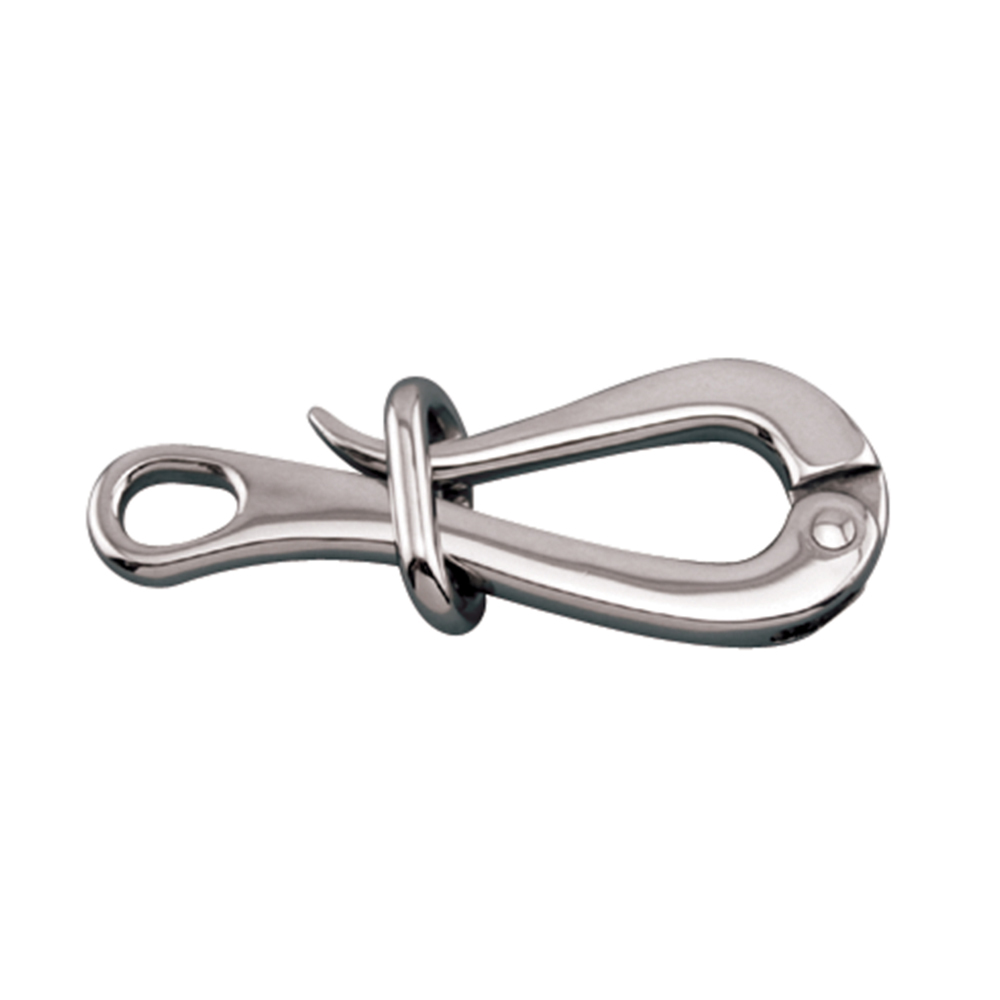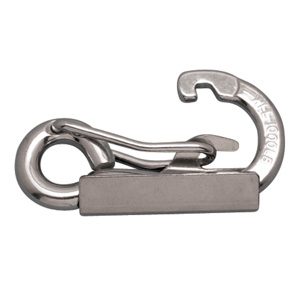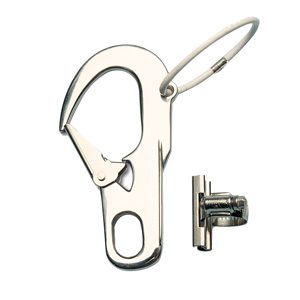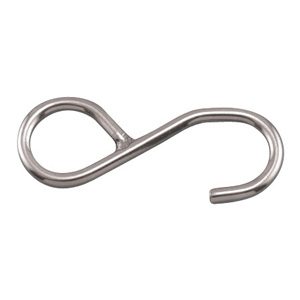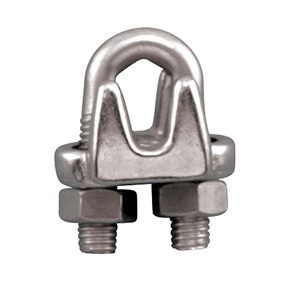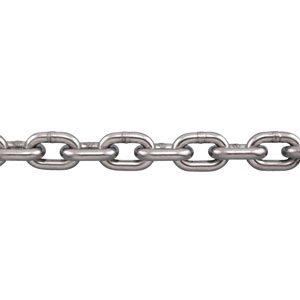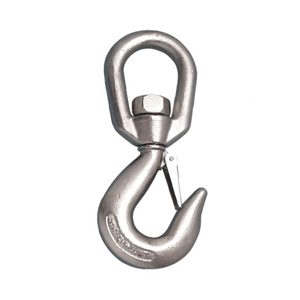Pelican hooks are a hinged hook that are frequently used with lifelines to close them securely. This stainless steel pelican hook is unsurpassed for appearance, strength and security. The long “bill” allows for you to easily grip and leverage to close the gate with lots of tension on the lifelines. There are no sharp angles to snag. This pelican hook is secured with a slide fitting and has an eye on the other end.
- Type 316 Stainless Steel
- Allows for easy opening while staying secure
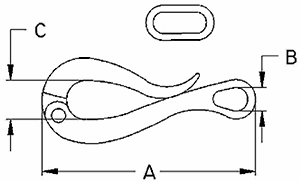
| Part # | A (in) |
B (in) |
C (in) |
WLL (lb) |
Wt (lb) |
| HKPS4 | 4.00 | 0.39 | 0.75 | 200 | 0.22 |
| HKPS6 | 6.00 | 0.51 | 0.97 | 300 | 0.56 |
Stainless Steel Information Center
General Information
The many unique values provided by stainless steel make it a powerful candidate in materials selection. Engineer, specifiers and designers often underestimate or overlook these values because of what is viewed as the higher initial cost of stainless steel. However, over the total life of a project, stainless steel is often the best value option.
What is Stainless Steel?
Stainless steel is essentially a low carbon steel which contains chromium at 10% or more by weight. It is this addition of chromium that gives the steel its unique stainless, corrosion resisting properties.
The chromium content of the steel allows the formation of a rough, adherent, invisible, corrosion-resisting chromium oxide film on the steel surface. If damaged mechanically or chemically, this film is self-healing, providing that oxygen, even in very small amounts, is present The corrosion resistance and other useful properties of the steel are enhanced by increased chromium content the the addition of other elements such as molybdenum, nickel and nitrogen.
There are more than 60 grades of stainless steel. However, the entire group can be divided into five classes. Each goup os stainles steel is identified by the alloying elements which affect their microstructure and for which each is named.
Lower alloyed grades resist corrosion in atmospheric and pure water environments, while high-alloyed grades can resist corrosion in most acids, alkaline solutions and chlorine bearing environments, properties which are utilized in process plants.Fire and Heat Resistance
Special high chromium and nichel-alloyed grades of stainless steel resist scaling and retain strength at high temperatures.Hygiene
The easy cleaning ability of stainless steel makes it the first choice for strict hygiene conditions, such as hospitals, kitchens, abattoirs and other food processing plants.
Strength-to-Weight Advantage
The work-hardening property of austenitic grades of stainless steel, that results in a significant strengthening of the material from cold-working alone, and the high strength duplex grades, allow reduced material thickness over conventional grades, therefor cost savings.
Ease of Fabrication
Modern steel-making techniques mean that stainless steel can be cut, welded, formed, machine and fabricated as readily as traditional steels.
Impact Resistance
The austenitic microstructure of the 300 series provides high toughness, from elevated temperatures to far below freezing, making these steels particularly suited to cryogenic applications.
Long Term Value
When the total life cycle costs are considered, stainless steel is often the least expensive material option. Stainless steel products complete their service life. There is less concern about disposal since this material is 100% recyclable. In fact, over 50% of new stainless steel comes from old remelted stainless steel scrap, thereby completing the full life cycle.
Electropolishing
Electropolishing is primarily used to obtain a bright, clean appealing surface of the stainless steel. However it also passivates the surface while removing burrs, sharp edges, microscopic nicks and scratches from the surface. It can smooth threads and remove heat discoloration form spot or TIG welds. Suncor electropolishes products to the ASTM STandard A967.
Passivating
Technically, passivation is not cleaning but is a process of dipping fitting into an acid solution to rapidly form a chromium oxide on the surface of the material, creating a passive film that protects stainless steel from further oxidation (see PASSIVE FILM). In common commercial terms (meaning non-military and aerospace), passivating means cleaning and the terms “passivating” and “cleaning” are used interchangeably. AN/MS/NAS fittings sold by Suncor have been cleaned, descaled, and passivated to the applicable engineering specifications.
AN – Stands for Air Force-Navy
ANSI – Stands for American National Standards Institute
ASME – Stands for American Society of Mechanical Engineers
ASTM – Stands for American Society of Testing and Materials
ANNEAL – To heat a metal in order to lower its hardness. The term anneal refers to the heat treatment given to 300 series of stainless steel and most 400 series stainless by the steel mill after the raw material has been completed, but before fittings are manufactured. Anneal also refers to the heat treatment given 400 series stainless fittings after their manufacture (also called hardening and tempering) to lower hardness and increase toughness. For example, fittings of 410 stainless steel may score over 200,000 psi after manufacture and be too brittle. By annealing at 1,000 degrees F., the tensile strength would reduce to 125,000-150,000 psi, while annealing the same material to 500 degrees F. would bring tensile to 160,000 to 190,000 psi.
BL – Stands for “Break Load”, meaning the weight at which a product will break. Typically, Suncor products have a minimum safety factor of 4:1.
“17-4 PH” – a chromium-nickel grade of stainless steel that has excellent mechanical properties at a high strength and hardness level. Scaling and distortion are minimal. Both the strength and corrosion resistance hold up well in temperatures to 800 degrees F., but material is magnetic.
“18-8” – 300 series stainless steel having approximately (not exactly) 18% chromium and 8% nickel. The term “18-8” is used interchangeably to characterize fittings made of 302, 302HQ, 303, 304, 305, 384, XM7 and other variables of these grades with close chemical compositions. There is little overall difference in corrosion resistance among the “18-8” types, but slight differences in chemical composition do make certain grades more resistant than others against particular chemicals or atmospheres. “18-8” has superior corrosion resistance to 400 series stainless, is generally nonmagnetic, and is hardenable only by cold working.
Electropolishing – Electropolishing is primarily used to obtain a bright, clean appealing surface. However it also passivates the surface while removing burrs, sharp edges, microscopic nicks and scratches from the surface. It can smooth threads and remove heat discoloration from spot or TIG welds. Suncor products are electropolished to ASTM Standard A967.
Elongation – Stretching a fitting to the point that it breaks. The percent of elongation at rupture (same as measure of ductility) is determined by dividing to total length after stretching to the original length. Elongation decreases as strength and hardness increase.
Galvanic Corrosion – An accelerated degree of corrosion occurring when tow different metals are in contact with moisture, particularly sea water. Al metals have what is termed a specific electric potential, so that low level electric current flows from one metal to another. A metal with a higher position in the galvanic series (see below) will corrode sacrificially rather than one with a lower position, meaning stainless, for example, will corrode before gold. The further apart the metals on the chart, the more electric current will flow and the more corrosion will occur. No serious galvanic action will occur by combining the same metals, only dissimilar ones. To prevent galvanic corrosion, use insulation, paint or coatings when separating dissimilar metals; or put the metal to be protected next to a metal which is not important in the assembly, so it can corrode sacrificially.
Metals listed first will corrode due to galvanic reaction before those at the end of paragraph: Magnesium, zinc, aluminum 1100, cadmium, aluminum 2024, steel and iron, lead, tin, brass, copper, bronze, monel, 304 and 316 stainless steel (passive), silver, titanium, graphite, gold.
ISO – Stands for International Organization for Standardization.
MS – Stands for Military Standards. The overriding characteristic of MS fittings compared to commercial products is the extensive inspection and lot traceability for MS, guaranteeing the chemical, physical and dimensional qualities. While commercial fittings may look similar and happen to pass many tests given MS products, the commercial fittings lack the pedigree of guaranteed quality or chemical, physical and dimensional aspects that users who order MS fittings rely on.
Magnetic Permeability – Test simply determines the level of magnetism. Virtually all Suncor stainless steel products have a value less than 2.5.
Molybdenum – Molybdenum is a metal added to 316 stainless steel, sharply increasing its corrosion resistance to chlorides and sulfates especially various sulfurous acids in the pulp industry. Molybdenum helps reduce hardness and increase tensile strength at higher temperatures.
Monel – Invented by the International Nickel Co., and composed basically to two-thirds nickel, one-third copper. Monel has good strength, excellent corrosion resistance against salt water and in high temperatures, but is very expensive.
Nitronic 50 – (UNS S20910) Invented by the Armco Steel Company, Nitronic 50 is a chromium-nickel-manganese-molybdenum austenitic stainless steel. It remains completely non-magnetic after severe cold working or exposure to low temperatures. Sought after for its higher strength and greater corrosion resistance.
NM – Stands for non-magnetic. Varying standards of magnetic units are applied to different metals for this designation.
Passivating – Technically, passivation is not cleaning but is a process of dipping stainless steel fittings into an acid solution to rapidly form a chromium oxide on the surface of the material, creating a passive film that protects stainless steel from further oxidation (see Passive Film). In common commercial terms (meaning non-military and aerospace), passivating means cleaning to users, and the terms “passivating” and “cleaning” are used interchangeably. A wide range of cleaning methods using different mixtures containing nitric, phosphoric and other acids or simply exposing cleaned stainless fittings to air for a period of time will result in a “passivated” condition. For properly cleaned fittings, it is impossible to determine the method of cleaning or passivation that was used. AN/MS/NAS fittings sold by Suncor have been cleaned, descaled, and passivated to the applicable engineering specifications.
Passive Film -The major characteristic of stainless steel is its ability to form a thin layer of protection called a “passive film” on its outside surface. This film results from a continual process of low-level oxidation, so oxygen from the atmosphere is needed for the passive film to exist. Once formed, it prevents further oxidation or corrosion from occurring. Even if chipped or scratched, a new passive film on stainless steel will form.
Pickling – Removing surface impurities by using chemicals. Used mainly to clean parts prior to coating. This treatment is more aggressive than passivation.
Pitting Corrosion – Pitting indicates deep corrosion in localized spots on a fastener. Dirt or grease on certain portions of a fastener may block oxygen from that surface, thus impeding the passive film which protects stainless steel from corrosion.
Proof Load – A test load that a stainless steel fitting must undergo without showing significant deformation. It is usually 50% +- of yield strength.
Solution Annealed (same as Carbid Solution Annealed) – A process of heating and removing carbide precipitants (carbon that has broken loose from its stainless steel solution) by heating a finished stainless fitting to over 1,850 degrees F. and cooling it quickly, usually in water, so carbon content goes back into the stainless solution.
Threads – Class 1 threads are a loose tolerance. Class 2 threads comprise 90% of stainless steel fittings and are normal commercial tolerance. Class 3 threads have a stricter tolerance and tighter fit such as socket cap and set screws. No definite relationship exists between tensile strength and tightness or looseness of fit. The symbol “A” added to threads, such as 2A, means external threads (screws), and “B” means internal (nuts).
WLL – Stands for “Work Load Limit”, this is the recommended weight limit for safe use of a product.

